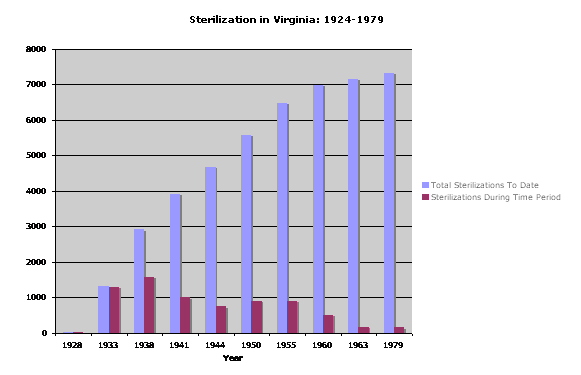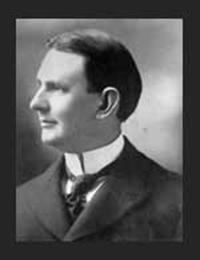Virginia
Number of victims
In total, 7325 individuals were sterilized in Virginia under its sterilization law. Of those sterilized about half were deemed “mentally ill” and the other half deemed “mentally deficient.” Approximately 62% of total individuals sterilized were female. Some estimate the total number of sterilizations as high as 8,300 individuals (Dorr, "“Defective or Disabled?", p. 382).
Period during which sterilization occurred
Sterilization in Virginia occurred under state law between 1924 and 1979. It thus appeared to have continued such sterilizations longer than any other state (Landman, pp. 83-4; Largent, p. 80).
Temporal pattern of sterilization and rate of sterilization

Although Virginia formally adopted a sterilization law in 1924, sterilization was not practiced widely until after the United State Supreme Court ruling against Carrie Buck in 1927. This ruling set a precedent on the legality of sterilization not only in Virginia but also throughout the nation. During the 1930’s, immediately after this Supreme Court ruling, sterilization in Virginia occurred at its highest rate with approximately 13 sterilizations per 100,000 state residents. After the 1930’s – prior to, during, and following WWII – sterilization initially decreased and thereafter maintained a fairly constant rate. After this, sterilization rates dropped dramatically until the practice faded out and then was subsequently forced out of practice with the repeal of the 1924 act in 1974 and the additional removal of all mention of sterilization from Virginia code in 1979.
On March 20, 1924, Virginia SB 281, the “Eugenical
Sterilization Act,” was signed into law (Landman, pp. 83-4).
Groups identified in the law
Under the Eugenical Sterilization Act, individuals confined to state institutions “afflicted with hereditary forms of insanity that are recurrent, idiocy, imbecility, feeble-mindedness or epilepsy” could be sterilized (Landman, p. 84).
Process of the law
In order for a sterilization to take place under the 1924
Eugenical Sterilization Act the superintendent of a colony or hospital had to present
the case for each individual to be sterilized in the form of a petition to a
special board of directors at said institution. A copy of this petition was
also required to be presented to the patient and the legal guardian of the
patient. Thirty days after the board deemed an individual fit for
sterilization, the sterilization was permitted to occur. Appeals were heard but
rarely considered. No individual involved in this process could be held civilly
or criminally liable. Additionally, nothing in the Eugenical Sterilization Act
could prevent a legally licensed doctor from partaking in a medical procedure
that could “incidentally involve the nullification or destruction of
reproductive functions” (SB 281, Virginia Sterilization Act; (Landman, p. 84).
Precipitating factors
and processes
The white, Virginia elite of the time was immersed in the
idea of perpetuating and protecting the purity of the “American race” (i.e.,
Anglo-Saxon Whites). This socioeconomic elite group wanted to maintain their
“traditional Southern identity” while also embracing modern progressive
ideology. The eugenic movement offered an avenue to pursue both of these
notions simultaneously. Through the embrace of eugenics as a progressive
science and ideology, Virginians were able to modernize their identity while
maintaining the purity of their state through the coerced sterilization of
minorities and undesirable whites alike (Dorr, "Assuring
America's Place," p. 262). Often, “mongrels” and
“worthless” whites were collected in “mountain sweeps.” This involved a sheriff
of a nearby town driving into mountain villages and forcibly removing
individuals and taking them to institutions where they would only be released
upon submission to sterilization (Black, pp. 3-8). More often than not these
individuals were unaware of the consequences of the procedures that they
underwent.
The sterilization of Virginia resident Carrie Buck is perhaps the most infamous case of sterilization in not only Virginia but also the United States as a whole. Buck was deemed “defective” and institutionalized in the Virginia Colony for Epileptics and Feebleminded four years after her mother was similarly institutionalized. Buck was classified as “feeble-minded” after giving birth to an illegitimate child as a result of rape by relative of her foster family. Her daughter was subsequently deemed feebleminded at the age of 6 months. Under accusations of hereditary defectiveness, Carrie Buck faced a series of trails and appeals used to legitimize her pending sterilization. With the 1927 Supreme Court ruling in Buck v. Bell, sterilization as legitimized and Buck was consequently sterilized to prevent the birth of more “defective” individuals. It was by Supreme Court Justice, Oliver Holmes that “three generations of imbeciles are enough.” Thus the legality of coercive sterilization in the United States to prevent the procreation of “defective” progeny was solidified (Lombardo, "Facing Carrie Buck," pp. 2-4; Paul, pp. 497-507).
The Virginia sterilization law was paramount to the
perceived legality of sterilization throughout the country. With the Carrie
Buck Supreme Court case of 1927, the American eugenics movement gained the
legitimacy necessary to avoid adversity in various courts (Paul, p. 497). This
ruling precipitated high rates of sterilization in Virginia and throughout the
rest of the United States. This sterilization pattern continued throughout the
first half of the twentieth century until rates began to decline in the
mid-1950s (Paul, p. 504). With the issue of “Recommendation 6” of the
Commission to Study Problems Relating to Children Born Out of Wedlock in 1959,
compulsory sterilization seriously questioned for the first time since its
legalization (Paul, pp. 504-6). Even in the presence of such concern, the 1961
report of the Virginia Advisory Legislative Council recommended no change to
the sterilization statute. At this time every other state in the Nation, with
the exception of North Carolina, had found reason to stop or slow sterilization
(Paul, pp. 506-9). Virginia enacted additional voluntary sterilization
legislation in 1962 (Windle, p. 307).
Groups targeted and
victimized
To Virginians, there seemed to be little difference between the harm to society caused by minorities and the harm caused by undesirable whites. During the time of sterilization, twenty-two percent of those sterilized were African American. This is roughly proportionate to the twenty percent of the total population represented by African Americans. In Virginia, sterilization rates were fairly proportionate to population representation (Dorr, “Defective or Disabled?", pp. 381-3). For this reason a wide array of individuals became targets for sterilization, specifically “mongrels,” minorities and poor whites. “Mongrels” are those who were considered to be of non-white heritage. In the opinion of Virginia, non-white was defined as any individual with any ancestor of any race but Caucasian, excluding those with 1/16th or less Native American blood. Additionally, institutionalized females who worked outside of the institution were sterilized at a higher rate than others due to their perceived risk of promiscuous interaction with the “normal” public (Claude Moore Health Sciences Library, p. 4).
Other restrictions placed on those identified in the law
On March 20, 1924 (the same day as the passage of SB 281, the “Eugenical Sterilization Act”) Virginia signed into law SB 219, the “Racial Integrity Act.” Under this piece of legislation to became “unlawful for any white person in [Virginia] to marry any [person] save a white person” (SB 219, Racial Integrity Act).
 (Photo origin: University of Virginia Health Systems' Claude
Moore Health Sciences Library, available
at http://www.hsl.virginia.edu/historical/eugenics/3-buckvbell.cfm)
(Photo origin: University of Virginia Health Systems' Claude
Moore Health Sciences Library, available
at http://www.hsl.virginia.edu/historical/eugenics/3-buckvbell.cfm)
While there were many major other proponents of eugenics and sterilization in Virginia, it is important to note the influence of Walter Plecker, the University of Virginia, and of the journal Virginia Medical Monthly. Walter Plecker, in his role as State Registrar at the Bureau of Vital Statistics, intended to maintain the purity of the states white race by classifying all residents in the state of Virginia by their race to prevent any intermarriage through the threat of prosecution of those who dissented (Black, pp. 165-70). It was under the great influence of Plecker and his racist rhetoric that the Racial Integrity Act of 1924 became law (Lombardo, "Medicine," p. 9).
Additionally, the University of Virginia acted as a highly respected educational institution that pushed the thought and science of eugenics through research and education. In the words of Dr. H.E. Jordan, Dean of the Department of Medicine at the University of Virginia, “eugenics… will work the greatest social revolution the world has yet known… [for] it aims at the production and the exclusive prevelancy of the highest type of physical, intellectual and moral man within the limits of human protoplasm” (Claude Moore Health Sciences Library). Having a similar influence, the Virginia Medical Monthly published medical reports from superintendents of various Virginia institutions as a method to increase the loathing toward those deemed feeble-minded while also spreading eugenics theory and practice. These proponents continued to condemn the “unfit” to sterilization and with their continual insistence of the necessity of sterilization, public support grew (Noll, Feeble-Minded, p. 61).
“Feeder institutions” and institutions where sterilizations were performed
 (Photo origin: University of Virginia Health Systems' Claude
Moore Health Sciences Library, available
at http://www.hsl.virginia.edu/historical/eugenics/3-buckvbell.cfm)
(Photo origin: University of Virginia Health Systems' Claude
Moore Health Sciences Library, available
at http://www.hsl.virginia.edu/historical/eugenics/3-buckvbell.cfm)
Sterilization and institutionalization also occurred at the Western State Hospital in Staunton, Virginia under the supervision of Joseph S. DeJarnette. With less frequency, sterilization occurred at Virginia’s Petersburg, Williamsburg and Marion Hospitals as well (Black, p. 4). These other institutions make no reference to their history in sterilization.
Commemoration
In 2002, a marker was erected to commemorate those sterilized under the Virginia sterilization law. The marker was erected by the Virginia Department of Historic Resources. The marker number is Q-28. It reads: “In 1924, Virginia, like a majority of states then, enacted eugenic sterilization laws. Virginia’s law allowed state institutions to operate on individuals to prevent the conception of what were believed to be “genetically inferior” children. Charlottesville native Carrie Buck (1906–1983), involuntarily committed to a state facility near Lynchburg, was chosen as the first person to be sterilized under the new law. The U.S. Supreme Court, in Buck v. Bell, on 2 May 1927, affirmed the Virginia law. After Buck more than 8,000 other Virginians were sterilized before the most relevant parts of the Act were repealed in 1974. Later evidence eventually showed that Buck and many others had no ‘hereditary defects.’ She is buried south of here” (Lombardo, "Historical Marker Database").
The location of the marker is 38° 2.202′ N, 78° 29.303′ W. It is located in Charlottesville, Virginia, on Preston Avenue (U.S. 250) 0.2 miles south of Grady Avenue (U.S. 250), on the left when traveling north. The approx. address is 800 Preston Avenue, Charlottesville, Virginia.
Opposition
Opposition outside of the Catholic Church appears to have been minimal throughout Virginia. While Catholics opposed sterilization in any form because such mutilation is in direct violation of “Natural Law,” it seems that the strong Protestant, white supremacist ideology present throughout much of the South allowed for eugenic sterilizations to go nearly unquestioned (Windle, p. 308). Very little information pertaining to the opposition to sterilization is available prior to Charles Windle’s case study on the passage of sterilization legislation in Virginia during the 1962 legislative session. During this session, a bill requiring the compulsory sterilization of women with more than one illegitimate child who is also receiving welfare benefits died in committee debate (Windle, pp. 306-7). While the compulsory sterilization proposal failed, a voluntary sterilization bill during the same session passed by a large margin (Windle, p. 307). It is important to note that this legislation was considered nearly forty years after sterilization was first legalized in Virginia and public opinion allowed for compulsory sterilization in 1924. Additionally, at the time these bills were considered, sterilization legislation was still on the books in Virginia. Even the Buck v. Bell case had little to do with any opposition to sterilization. Rather, this case was a ploy by eugenicists to set a nationwide standard of sterilization legality by taking appeals to the United States Supreme Court (Claude Moore Health Sciences Library). Moreover, Virginia is a traditionally agrarian state and sterilization legislation (when considered in 1962) was widely supported by individuals concerned with race relations and welfare in “poorer, nonurban areas with high proportions of nonwhites and of agricultural and manufacturing employment” (Windle, p. 314). The number of sterilizations that continued to occur into the 1970’s is a testament to the stronghold of eugenic ideology throughout the state.
Black, Edwin. 2003. War against the Weak: Eugenics and America’s campaign to Create a Master
Race. New York: Four Walls Eight Windows.
Claude Moore Health Sciences Library,
University of Virginia Health System. "Eugenics: Three Generations, No
Imbeciles: Virginia, Eugenics, and Buck v. Bell." Available at <http://www.hsl.virginia.edu/historical/eugenics/index.cfm>.
Dorr, Gregory M. 2006. “Defective or Disabled?:
Race, Medicine, and Eugenics in Progressive Era Virginia and Alabama.” Journal
of the Gilded Age and Progressive Era 5, 4: 359-92.
Dorr, Gregory Michael. 2000. "Assuring
America's Place in the Sun: Ivery Foreman Lewis and the Teaching of Eugenics at
the University of Virginia, 1915-1953." Journal of Southern History
66, 2: 257-96.
Landman, J. H. 1932. Human Sterilization: The History of the Sexual Sterilization Movement. New York: MacMillan.
Largent, Mark A. 2008. Breeding Contempt: The History of Coerced Sterilizatioin in the United States. New Brunswick: Rutgers University Press.
Lombardo, Paul. "Eugenic Sterilization
Laws." Image Archive on the American Eugenics Movement. Available at
<http://www.eugenicsarchive.org/html/eugenics/essay8text.html>.
Lombardo, Paul A. 2008. “The Historical Marker
Database: Buck v. Bell.” Available at <http://www.hmdb.org/marker.asp?marker=10128>
Lombardo, Paul A. 2003. "Facing Carrie Buck." Hastings Center Report 33, 2: 14-17.
Lombardo, Paul A. 1996. "Medicine, Eugenics, and the Supreme Court: From Coercive Sterilization to Reproductive Freedom." Journal of Contemporary Health Law and Policy 13, 1: 1-25.
Noll, Steven. 2005. “The Public Face of Southern Institutions for the ‘Feeble-Minded.’” The Public Historian 27, 2: 25-42.
Noll, Steven. 1995. Feeble-Minded in Our Midst: Institutions for the Mentally Retarded in the South, 1900-1940. Chapel Hill: University of North Carolina Press.
Paul, Julius. 1965. “‘Three Generations of
Imbeciles Are Enough’: State Eugenic Sterilization Laws in American Thought and
Practice.” Unpublished manuscript. Washington, D.C.: Walter Reed Army Institute
of Research.
Windle, Charles. 1965. "Factors in the Passage of Sterilization Legislation: The Case of Virginia." The Public Opinion Quarterly 29, 2: 306-14.